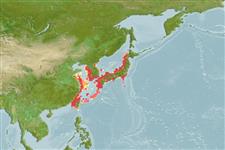>
Tetraodontiformes (Puffers and filefishes) >
Tetraodontidae (Puffers) > Tetraodontinae
Etymology: Takifugu: A Japanese word with several meanings; taki = waterfall + fugu = fish; it could be also understood as taki = to be cooked in liquid + fugu = a venomous fish.
More on authors: Temminck & Schlegel.
Environment: milieu / climate zone / intervalo de profundidade / distribution range
Ecologia
marinhas; Água doce; estuarina demersal; não migratória. Temperate; 46°N - 21°N, 119°E - 142°E
Northwest Pacific: western part of the Sea of Japan and the East China and Yellow seas northward to Muroran, Hokkaido, Japan.
Tamanho / Peso / Idade
Maturidade: Lm ? range ? - ? cm
Max length : 80.0 cm TL macho/indeterminado; (Ref. 56527); common length : 40.0 cm TL macho/indeterminado; (Ref. 637)
Descrição breve
Chaves de identificação | Morfologia | Morfometria
Espinhos dorsais (total) : 0; Raios dorsais moles (total) : 16 - 19; Espinhos anais: 0; Raios anais moles: 13 - 16; Vértebras: 21 - 22. Body covered with prickles; presence of a large round black blotch edged with a white line on side just behind pectoral fin (Ref. 559).
Body shape (shape guide): fusiform / normal.
Adults are found in inlet waters, occasionally entering brackish waters. Fingerlings are often seen in brackish river mouths (Ref. 58920). Move offshore with growth. Breed in the sea (Ref. 58920) from March to May; attach eggs to rocks in shingly areas at depths of around 20 m. Liver and ovaries extremely toxic, intestines slightly toxic; flesh, skin and testes not poisonous. Juveniles resemble Takifugu niphobles (Ref. 637). A prized food fish in Japan. Said to be commercially cultured in Japan at present. Used in Chinese medicine (Ref. 12166). One of the first vertebrates whose genome has been sequenced completely, 31,059 genes coding for 33,609 proteins (Ref. 58917).
Life cycle and mating behavior
Maturidade | Reprodução | Desova | Ovos | Fecundidade | Larvas
Masuda, H., K. Amaoka, C. Araga, T. Uyeno and T. Yoshino, 1984. The fishes of the Japanese Archipelago. Vol. 1. Tokai University Press, Tokyo, Japan. 437 p. (text). (Ref. 559)
Categoria na Lista Vermelha da IUCN (Ref. 130435: Version 2025-1)
Ameaça para o homem
Poisonous to eat (Ref. 637)
Utilização humana
Pescarias: altamente comercial; Aquacultura: espécies comerciais
Ferramentas
Relatórios especiais
Descarregue XML
Fontes da internet
Estimates based on models
Preferred temperature (Ref.
123201): 13.5 - 23, mean 19 °C (based on 96 cells).
Phylogenetic diversity index (Ref.
82804): PD
50 = 0.5000 [Uniqueness, from 0.5 = low to 2.0 = high].
Bayesian length-weight: a=0.01622 (0.00726 - 0.03621), b=2.92 (2.74 - 3.10), in cm total length, based on LWR estimates for this (Sub)family-body shape (Ref.
93245).
Nível Trófico (Ref.
69278): 3.6 ±0.57 se; based on food items.
Resiliência (Ref.
120179): Médio, tempo mínimo de duplicação da população 1,4 - 4,4 anos (K=0.15-0.17; assuming tm<5).
Fishing Vulnerability (Ref.
59153): Low to moderate vulnerability (30 of 100).
🛈
Nutrients (Ref.
124155): Calcium = 33.8 [12.1, 75.6] mg/100g; Iron = 0.417 [0.219, 0.855] mg/100g; Protein = 18.9 [16.7, 21.2] %; Omega3 = 0.664 [0.289, 1.400] g/100g; Selenium = 17.1 [7.6, 37.7] μg/100g; VitaminA = 5.76 [2.01, 17.07] μg/100g; Zinc = 0.506 [0.365, 0.732] mg/100g (wet weight);
